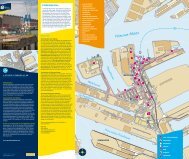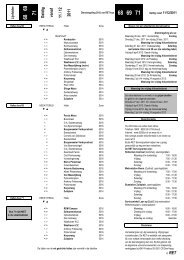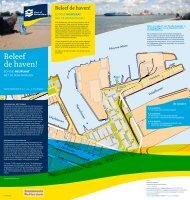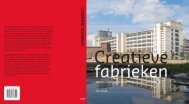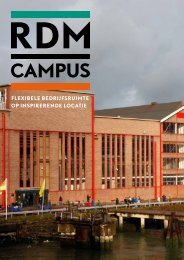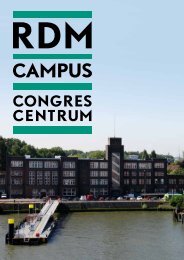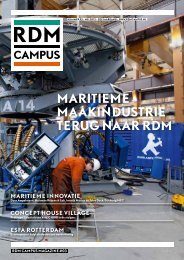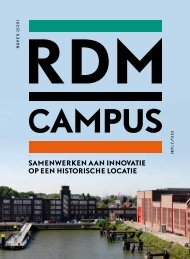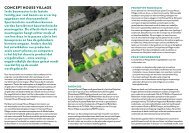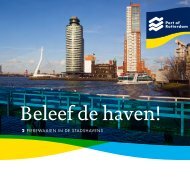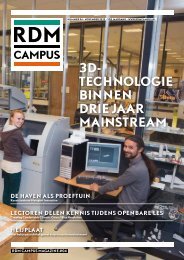32 <strong>Creating</strong> <strong>Comfortable</strong> <strong>Climatic</strong> <strong>Cities</strong>33<strong>Creating</strong> <strong>Comfortable</strong> <strong>Climatic</strong> <strong>Cities</strong>04 Tools and Methodologies forIntegral SustainabilityThe architectural service sector is not yet adequately geared to tackling theissues relating to climate change and resource and energy efficiency. Although alot of research has been done into all these topics, the gap between science andpractice is immense. The mainstream building sector is governed by old-fashionedprinciples and techniques, making it difficult to implement innovative solutions ona large scale. Moreover, designers may themselves prove to be the biggest obstaclein achieving real change. Critics argue that the Green agenda limits the potentialfor design and leads to ugly buildings. Compact volumes and limitations on the sizeand positioning of openings are viewed as unwelcome design constraints, limitingcreativity and potentials for architectural expression (Maas et al., 2010). Indeed, thereare few examples of aesthetically well designed Green buildings, compared with thearray of bad examples where the tell-tale Green attachments such as solar panels andwindmills dominate the overall image. To overcome this shallow commodification ofGreen, it is imperative that the potentials for a rich, integrally sustainable languageare explored and translated into design instruments for widespread adoption by thedesign community.For many architects and builders the perceived complexity that Green brings to thebuilding arena is also an obstacle. New technologies, knowledge of materials andlife cycle analysis, and the multitude of certification and validation systems, suchas LEED, Cradle to Cradle, and BREEAM, introduce more constraints to the designprocess. The development of BREEAM NL by the Dutch Green Building Counciland the introduction of the Material Performance Coefficient (MPC) in 2013 willundoubtedly help to simplify the rules of engagement. Although these tools areabsolutely necessary to evaluate aspects of the sustainability of a project, they arealso limited in the sense that they cannot address the complexity of sustainability ata systems level and a city scale. These tools take on greater meaning when appliedwithin the context of broader issues, made possible, for example, by tools such as SiD(Symbiosis in Development). SiD is a methodology for solving complex, multifacetedproblems using systems thinking, network theory and life cycle understanding.SiD combines theory, method, practice and tools in one holistic system that allowsdifferent disciplines to work together, evaluate sustainability spectrum-wide, and findsymbiotic solutions quickly (Bosschaert and Gladek, 2010).SiD and a broad range of similar tools and methodologies now under developmentcan facilitate a more integral design process by helping designers to deal withmore design constraints and performance criteria. Besides tools for achieving ecoefficiency,some tools, such as BIM (Building Information Modelling), focus on theprocess of integrated design.
34 <strong>Creating</strong> <strong>Comfortable</strong> <strong>Climatic</strong> <strong>Cities</strong>35<strong>Creating</strong> <strong>Comfortable</strong> <strong>Climatic</strong> <strong>Cities</strong>Building Information Modelling (BIM)The Government Buildings Agency stipulates that from 1 November 2012, BIM (BuildingInformation Modelling) must be used by design teams for all DBFMO (Design, Build,Finance, Maintain & Operate) tenders. Architects, builders and engineers will worktogether on one central virtual building model, the BIM model. By exchanging theirinformation in a structured manner using open source standards, all the partnersin the building chain will create a complete centralised digital description of thebuilding. The overall timeframe for the process remains the same, although moretime is spent on communication and exchange of information than in a traditionaldesign process. Increased communication and interaction in an early phase can leadto better solutions, and the use of BIM limits the margin of error experienced intraditional building processes in which each partner has their own model and drawingset. The use of BIM will increase exponentially in the decades to come. It is a usefultool as it facilitates communication and exchange of information and thus promotestransdisciplinary collaboration.REAP+REAP+ is a methodology or approach for use by architects and urban designers toincrease integral sustainability through design. It is based on the Rotterdam EnergyApproach and Planning (REAP, Tillie et al., 2009) and is currently under development. REAP+expands the three-step strategy for energy (van den Dobbelsteen et al., 2008) to includewater, materials and waste. The strategy involves reducing resource inputs, waste andemissions by improving urban processes (see Figure 12). It addresses the complexity ofthese urban systems, and takes into account the interrelations of resource flows. Thefundamental concept is the continuous upgrading of anthropogenic systems to attainclosure of material, waste, water and energy cycles at the building, cluster, districtand city scales. When combined with innovative co-creative processes, this approachleads to more integrated forms of sustainability in which energy, water, materials andwaste systems are designed efficiently and brought into balance with natural systemsat the appropriate physical scale and within the appropriate time frame.Figure 12.REAP+, the three-step strategy for integral sustainability, based on REAP (Tillie et al., 2009) and theNew Stepped Strategy (van den Dobbelsteen, 2008). [Doepel Strijkers, 2009]The strategy involves three steps and is organised by scale (from the building, cluster,district to city scale):Step 01. Reduce demand (energy, water, materials and waste)Step 02. Reuse waste streams (waste = resource)Step 03. Produce sustainably (on the appropriate scale)Energy, water, materials and waste are seen as layers in spatial planning, eachwith their own logic and economy of scales. REAP+ offers designers a step-by-stepapproach, facilitating the mapping of each system and its boundaries. By overlappingthe different layers, designers get a grip on where the systems interact, which helpsthem to determine the spatial parameters for the design of the physical interface.Anthropogenic and natural systems also connect at different scales, offering potentialsfor increasing biodiversity and embedding a building within its wider context. REAP+ isan approach that gives designers an understanding of the complexity of the differentphysical urban systems and how they could interact to inform design decisions.Climate as an instrument for designBioclimatic designBioclimatic design aims to improve human thermal comfort by natural conditioning,conserving resources, and maximising comfort through design adaptations to sitespecificand regional climatic conditions (Hyde, 2008). It is characterised by strategiesto reduce or eliminate the need for non-renewable energy resources (for artificialconditioning) by optimising the orientation, building form, envelope, interiorconfiguration and shading of a building.Research suggests that bioclimatic buildings use five to six times less energythan conventional buildings over their lifetime (Jones, 1998). Energy consumption inbioclimatic buildings is reduced primarily by designing the building form and envelopeto make use of the local microclimate (see Image 8). In warm climates, where cooling isneeded most of the year, 34% of energy consumption in buildings is used for airconditioning, resulting in high energy use and greenhouse gas emissions. In mostcases this is due to the poor design of the building envelope (Parlour, 2000). But by usingparameters such as air temperature, solar radiation, wind and humidity as inputs toarchitectural and urban design, the climate itself can become a ‘design instrument’.In the current Dutch context, bioclimatic design principles find expression in conceptssuch as the passive and active house. As heating is the primary need for housingin the Netherlands, these strategies focus on reducing the heating demand byimplementing passive solar principles. Sun, wind and light are the main elementsutilised in passive design. An example of how passive solar strategies can impact onthe form and use of the dwelling is the use of winter gardens and patios as interstitial(buffer) zones. These interstitial spaces lengthen the summer season by capturingspring and autumn sunlight and using it to lower the heating demand of the dwelling.



